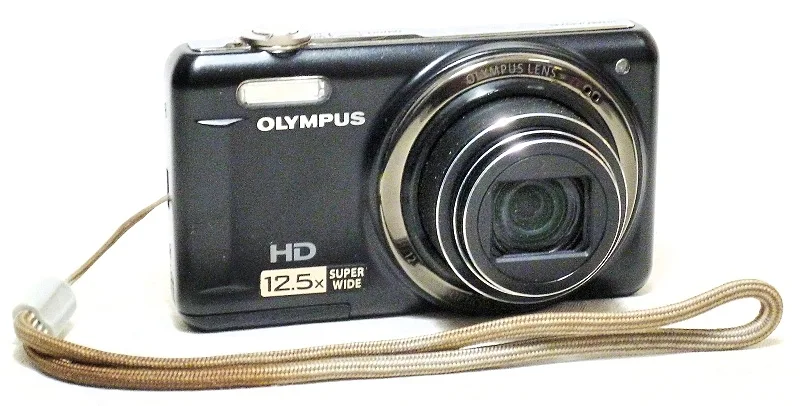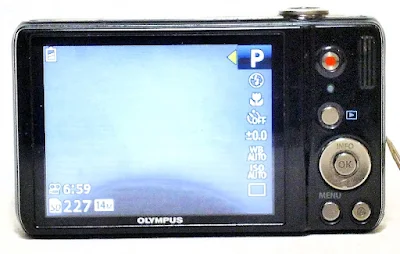A charming and eligible candidate for beginner CCD enthusiasts is the very affordable 16MP CCD compact travel zoom Olympus VR-320, launched by Olympus in 2011 as a replacement for the VR-310 which was launched earlier. The VR-320 features a 4.2-52.5mm (12.5x optical zoom) lens, dual image stabilization (mechanical and software enhanced), 720p HD movie capture, a 3-inch LCD screen, a 1 cm super macro mode, a range of Magic Filters, auto-focus tracking, and Intelligent Auto Mode. The VR-320 is available in silver, black, red, and blue.
The camera is encased in a sheen metal body, measures 100.6 x 58.2 x 28.5mm, and weighs 158g with battery and SD or SDHC card loaded. Images may also be stored in the camera's 33MB internal memory. Fitted is a 9-element in 8-group lens with 4 Aspherical and 2 ED glass elements, with a maximum aperture of 3.0 - 5.9. The camera's ISO sensitivity is from 80 to 1600, and the shutter speed range is from 1/2 - 1/2000 second which will go down to 4 seconds in Candle scene mode.
The user interface on the VR-320 is a straightforward menu system with a selection of Program, iAuto, Scenes, Magic Filters, and Panorama shooting modes. Scenes include Portrait, Landscape, Night Scene, Night Scene with Portrait, Sports, Indoor, Candle, Self-portrait, Sunset, Fireworks, Cuisine, Documents, Beach and Snow, and Pet. At the same time, Magic Filters lets you access Pop Art, Pinhole, Fisheye, Drawing, Soft Focus, Punk, and Sparkle effects.
Main Camera Features
The simple and clean lines of the VR-320 show a camera front dominated by that zoom lens assembly, which retracts back into the body when the camera is inactive, a built-in microphone on the outer ring of the lens mount assembly, and on the flush surface of the front, a small indicator lamp for the AF assist/self-timer, and, to the left of the lens, a lozenge-shaped window for the built-in flash.
The top plane of the camera is occupied by the Power On/Off switch, and the Shutter Release button encased within the zoom ring lever. The battery compartment, with the SD card slot within it, the tripod socket, and a USB port for power connections are on the bottom plate. The VR-320 is one of the few cameras I have seen that can be charged in situ, with the battery inside the camera being charged all the time the camera is connected to the USP port.
On the back, to the right of the LCD screen, are the to get you the best of the camera. These include the Movie, Playback, the Four-Way Control Pad with a central OK, Menu, and Menu Guide buttons. Exposure mode selection is first accessed by the down arrow on the Four-Way Control Pad, next with the left or right arrows to move between the mode selection, and finally, the down arrow again to set the parameters of the menu selection.
The VR-320 shoots in 2 basic auto modes, iAUTO, which allows the camera to automatically select the proper scene mode for the shooting situation, and Program Auto (similar to Intelligent Auto except but without the automatic scene mode selection) where you can add adjustments to the settings for Flash, Macro, Self-Timer, Exposure Compensation, White Balance, ISO, and also the settings on the Main Shooting Menu.
The CCD Sensor
CCDs, as we know them, were the standard for camera sensors from the early 80s till the late 2000s, acknowledged for their low noise and high-quality images that were almost film-like. Though replaced on the digital camera by the CMOS variety, more for production technology reasons rather than the quality of images they produced, CCDs are still used in areas of specialized photography including Optical Microscopy, Space Photography, and Near-Infrared imaging.
CCD photography, an option that is seen as an alternative to the ever-increasing cost of film for film photography and its associated development timeline costs, is experiencing a resurgence that looks likely to have a snowball effect as more and more enthusiasts are looking at the option.
Early Images
Early images here include the ubiquitous look over to the dining table and the clutter on my work table, two images that are almost standard on my camera review pages, and pointers to the image quality the camera is capable of capturing. Other include scenes in the community garden across the street from my home for the zoom range, a couple of close-ups, more scenic, and a couple of visual peps created with the Magic Filter in Drawing mode.
In Use
The Olympus VR-320, though with a menu system that is a bit archaic when compared to later model cameras, is full of surprises as to what you can do and be creative with it, with images that are par excellence, and fully functional with just a USB port connectivity, and you will have a digital travel zoom that is fun and easy to use.
As a low-cost start to your interest in the CCD image genre, acquiring the VR-320 will not break the bank, nor put you in direct competition with the more sophisticated and complex smartphone you are using. It is just a simple point-and-shoot vintage digital camera with a super-wide 24mm to 300mm equivalent zoom lens to take along for a fun outing with family and friends, and travel.































No comments:
Post a Comment